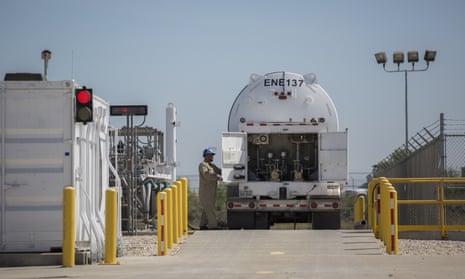The price of natural gas in the US has risen by nearly half in the past month, as drought and the war in Ukraine continue to bite and millions of Americans turn up their air conditioners in a heatwave.
Natural-gas futures jumped 48% this month, including 10% on Wednesday, to $8.007 per million British thermal units (btu). The rise has come as other energy costs, including oil, have begun to drop from their June peaks.
A ferocious continental heatwave is projected to last into August. On Wednesday Joe Biden announced a group of measures to tackle the climate emergency, though he held back from declaring a national climate emergency as some had hoped.
The heat is also testing aging power grids, as consumers use high amounts of electricity. In Texas, a global hub for cryptocurrency mining, bitcoin miners shut off their machines amid warnings of rolling black-outs.
The rising price of gas, along with coal, could dash hopes for an end to inflation any time soon. Some saw recent falling commodity prices as a signal that inflation, now running at 40-year high of 9.1%, could be close to peaking.
But higher natural gas prices, the Wall Street Journal noted on Thursday, contribute to rising prices for the fertilizer, steel, cement, plastic and glass industries as well as the immediate costs in electricity production.
Some US electricity utility companies have warned that summer prices could be 25% higher this year than last year. “The entire country is running their air conditioners,” Eli Rubin, senior analyst at the energy consultant EBW Analytics, told the Journal.
Gas prices have surged also as a result of demand from overseas buyers, especially in Europe, where the war in Ukraine has threatened supplies from Russia.
On Thursday, Gazprom resumed gas shipments through the Nord Stream 1 pipeline to Germany after a 10-day shutdown. Deliveries remain at just 40% of full capacity, however, raising the prospect of gas rationing over the coming winter.
Europe uses less natural gas in the summer than the US does, as domestic air-conditioning is comparatively rare.
But the US heatwave has also upended natural gas price expectations in the US. After a liquefied natural gas (LNG) export plant in Houston, Texas, was damaged by fire in June, traders anticipated that US gas prices would drop significantly – given that the gas could no longer be exported abroad and would have to be reserved for the domestic market.
Instead, extreme heat has caused gas prices to surge. Freeport LNG, the company that operates the terminal, has said it does not expect the plant to return to partial service until October.
Gas prices in Europe have now jumped around 40%. The disaster also upended the White House plan to export gas to Europe to offset the loss of Russian supplies.
Unlike Germany, US electricity producers cannot easily switch from gas to coal (which itself has risen in price by one-third in the past year), as a third of coal-burning plants have been retired since 2010.
Electricity producers are also contending with reduced hydropower owing to drought in the western US. The Energy Information Administration estimates that California hydroelectricity will be half its normal output this summer if the drought continues.
